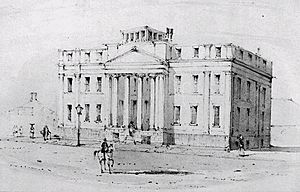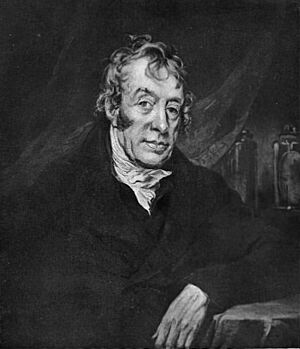Manchester Mummy facts for kids
Hannah Beswick (born 1688 – died February 1758) was a rich woman from Hollinwood, near Oldham. She had a very strong fear of being buried alive by mistake. Because of this fear, after she died in 1758, her body was specially preserved, or embalmed. It was kept above ground so that people could regularly check if she was truly gone.
The exact way her body was preserved isn't fully known. But it probably involved replacing her blood with a mix of turpentine and a red pigment called vermilion. Her body was then placed inside an old clock case. It was kept at the home of her family doctor, Dr. Charles White. Hannah Beswick became quite famous locally because of her unusual wishes. Many people were allowed to visit Dr. White's house to see her.
Later, Hannah Beswick's preserved body was given to the Museum of the Manchester Natural History Society. There, she was put on display and became known as the Manchester Mummy. Eventually, the museum's collection moved to Manchester University. It was then decided, with permission from the Bishop of Manchester, that Hannah Beswick should finally be buried. Her burial happened at Harpurhey Cemetery on July 22, 1868. This was more than 110 years after she had died! Her grave today does not have a marker.
Contents
Why Hannah Feared Burial
The mid-1700s was a time when many people worried about being buried alive by mistake. There was a lot of talk about how hard it was to know for sure if someone was truly dead. People suggested different ways to check for signs of life before burial. Some ideas were quite strange, like pouring vinegar and pepper into a body's mouth.
Hannah Beswick was born in 1688. She inherited a lot of money from her father, who passed away in 1706. Years before Hannah died, her brother, John, had a very close call. Just as his coffin lid was about to be closed, a person mourning noticed his eyelids seemed to flicker. The family doctor, Dr. Charles White, checked him and confirmed John was still alive. John woke up a few days later and lived for many more years. This event likely made Hannah's fear of premature burial even stronger.
How Her Body Was Preserved
Hannah Beswick's will, written in 1757, doesn't actually say she wanted to be embalmed. Some people think Dr. White was only asked to keep her body above ground until it was clear she was truly dead. But it's thought he couldn't resist adding a mummy to his collection of interesting items. So, he decided to preserve her body.
Dr. White was very interested in anatomy, which is the study of the body's structure. He had a collection of "curiosities." By the time he died, his collection included the skeleton of a highwayman (a robber who attacked travelers) and, of course, Hannah Beswick's mummy.
The Manchester Mummy on Display
At first, Hannah Beswick's preserved body was kept at Ancoats Hall, the home of another Beswick family member. But it was soon moved to a room in Dr. White's own house in Sale, Manchester. There, it was stored inside an old clock case.
Because of her unusual will, Hannah became famous. Even the writer Thomas de Quincey went to Dr. White's house to see her. After Dr. White died in 1813, Hannah's body was given to another doctor, Dr. Ollier. When Dr. Ollier died in 1828, the body was donated to the Museum of the Manchester Natural History Society. This is where she became widely known as the Manchester Mummy.
She was displayed in the museum's main hall, placed next to mummies from Peru and Egypt. Her relatives were allowed to visit her whenever they wished. In 1844, a visitor described her as "one of the most remarkable objects in the museum."
There are no pictures of Hannah Beswick herself. But a local historian named Philip Wentworth described her body:
The body was well preserved but the face was shrivelled and black. The legs and trunks were tightly bound in a strong cloth such as is used for bed ticks [a stiff kind of mattress cover material] and the body, which was that of a little old woman, was in a glass coffin-shaped case.
Soon after the museum's collection moved to Manchester University in 1867, it was decided that Hannah Beswick was "unmistakably dead." It was time for her to be buried. However, since 1837, a law in the UK required a medical examiner to issue a death certificate before a burial. Since Hannah had died in 1758, a special request had to be made to the government. They issued an order for her burial. With permission from the Bishop of Manchester, Hannah Beswick was finally buried in an unmarked grave at Harpurhey Cemetery on July 22, 1868. This was more than 110 years after her death.
Hidden Treasure and Ghost Stories
In 1745, a Scottish prince known as Bonnie Prince Charlie led his army into Manchester. This made Hannah Beswick worried about her money, so she decided to bury it. Shortly before she died, she promised to show her relatives where the treasure was hidden. But she passed away before she could.
After her death, her home, Birchin Bower, was turned into apartments for workers. Several people living there claimed to have seen a ghost. They described it as a figure dressed in a black silk dress and a white cap, saying it looked like Hannah Beswick. The ghost would glide across the living room and then disappear at a certain stone on the floor. It's said that a weaver living there later found Hannah's hidden gold under that very stone while digging for a new weaving machine.
Birchin Bower was eventually torn down to build a factory. But even after the house was gone, people still reported seeing the ghost.
In 1890, Hannah Beswick's family home, Cheetwood Old Hall, was also demolished. Workers found a double coffin buried under the drawing room. The mystery of this burial was never solved. But at the time, people thought it might be connected to the Beswick family and Dr. White, who had lived in the hall after Hannah moved to Oldham.
Images for kids





